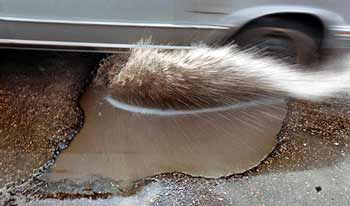 KINGSTON, R.I. – March 1, 2011 – It’s pothole season again, the time when even careful drivers may wind up with a flat tire or a shimmy in their vehicle from the jolt of slamming into a recently opened crater in the roadway.
KINGSTON, R.I. – March 1, 2011 – It’s pothole season again, the time when even careful drivers may wind up with a flat tire or a shimmy in their vehicle from the jolt of slamming into a recently opened crater in the roadway.
While there is little that drivers can do other than snake their way around the massive cavities, understanding pothole science may make you empathize a bit with the highway workers who try mightily to keep up with this seasonal mess.
According to K. Wayne Lee, URI professor of civil engineering, all of the conditions that are ideal for creating abundant potholes occur in Rhode Island.
“Instead of freezing all winter long like it does farther north, roadways in Rhode Island repeat the freezing-thawing cycle that cause potholes over and over again,” he said. “So it appears that Rhode Island is more pothole prone than other areas.”
Lee said that potholes typically form because asphalt road surfaces eventually crack under the daily winter temperature cycles and the constant stresses of traffic.
“As the snow melts during a warmer period of the winter, the resulting water seeps into the pavement, and the added moisture softens the paving material,” he said. “Once the temperature drops again, the water freezes and expands, widening whatever crevices it came in through. The more water that was present and the more often the freezing and melting cycles occurred determines how large the pothole will become.”
The final piece of the pothole puzzle, he said, is traffic.
“During the pothole process, the affected pavement is greatly weakened, so much so that the softer piece of pavement easily breaks off and comes out around the crevices left by the freezing process. The more cars that drive over these weak surfaces, the more pavement will break off.”
Lee, who has been conducing research on pavement engineering for nearly three decades and who serves as director of the Rhode Island Transportation Research Center, said that today’s roads are built to reduce their moisture susceptibility, which should result in fewer potholes. But efforts to engineer better roads are countered by an ever-increasing number of heavier vehicles on the road.
It doesn’t help that reduced state and municipal funding has meant that inferior materials or the “under-design” of highways may cause roads to have more problems than they otherwise would.
The short-term solution to potholes is the use of cold-patch, a cold mix of asphalt that doesn’t require heating or regular rolling and can be used to quickly make repairs to damaged roads. But it should only be a temporary solution. Lee said that all potholes should be cleaned, cut and primed with liquid asphalt and patched with hot mix asphalt when the weather warms. Unfortunately, in many areas, that step is often skipped.
“I trust that the 39 cities and towns in Rhode Island are doing their best,” Lee said. “But with limited funding and insufficient state support, I know they are having difficulties keeping up.”
Which means that drivers on Rhode Island roadways should prepare for a few more months of hazardous driving conditions.

